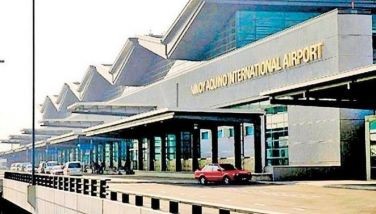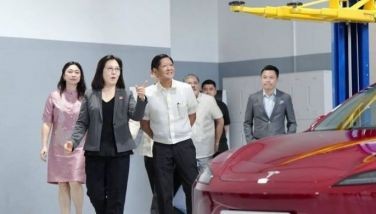BBM’s diplomatic offensive can also be a learning process

The state visits to Indonesia and Singapore of President Marcos so early in his term signals the importance he places to diplomacy as part of the job of leader.
Through diplomacy, we foster closer relations along economic, political and cultural dimensions with other nations. When diplomacy works, it is easier to use it as a tool for national development.
ASEAN neighbors first. It is symbolic and significant that the President begins his diplomatic efforts in our immediate neighborhood by visiting two of our closest ASEAN neighbors in our Asian region. They are also good examples of economic success stories.
Aside from creating a vehicle for personal contact and familiarity among the principal leaders of nations, they can help facilitate the strengthening of bilateral relations on many fronts.
It is especially important for a new leader to expand his horizon of familiarity with the intricacies of foreign relations. Direct diplomacy can help strengthen the learning process of a new leader on the job.
There are also many things that we can learn from the experience of our neighbors who have developed a track record of consistent economic success in economic growth, in the midst of many global and regional crises that continually challenge all nations. They have come out with relative success.
In 1967, Indonesia and Singapore were among the original five ASEAN founding nations along with Malaysia, Thailand, and our own country. Today, it is an enlarged regional bloc of 12 countries. By 1992, the ASEAN agreed to form a free trade agreement. This agreement has further cemented closer economic cooperation, fostering greater regional trade, and has demonstrated a collective enlargement of intra-ASEAN trade while becoming also an attractive regional trading bloc with the other economies of the large global world.
Both Indonesia and Singapore have strongly profited from the success of ASEAN as an economic grouping. For one, they have become strong magnets for the inflow of foreign capital into their countries in the last few decades.
As a nation, we have also shared in the benefits from membership in the ASEAN. However, we have yet to partake of the full share of the benefits that other successful member countries have enjoyed, like Indonesia and Singapore.
The President is accompanied by his economic managers in these State visits. They can surely provide him with their own assessment of why we have fallen behind in maximizing our gains.
Like all the rest of ASEAN, we were ready to reduce the barriers to trade derived from tariff protection, but we were slow in reducing the protectionist elements in our resource policies. In particular, this applies to land, labor, and capital.
Many of these issues are precisely the topics of discussion in the pages of this column over the years. Some of these policies were only recently lifted by economic reforms undertaken in the last Philippine Congress. The present administration still has to deal with further economic liberalization along these lines.
It is a lesson for us to introduce a further liberalization of economic policies in our country so that we can share in the progress of ASEAN as a whole. Hopefully, this will be a lesson that our President will find out in his discussions with his leadership peers in ASEAN.
Indonesia’s progress. Indonesia’s population of 275 million is the most populous in ASEAN. Its economic success in recent years is marked by the fact that its GDP per head, according to World Bank conversion, is $4,292. (Our own corresponding GDP per head is $3,549.) It has now graduated to middle income status among developing nations and is currently on a path toward more economic progress.
One dimension of development is population growth. Indonesia has reduced its population growth rate much better than we have. As a result, a one percent growth of the economy brings in a greater gain in welfare for the average Indonesian than for the Filipino. There is a smaller burden of public support for poor families on the state when population growth is less. Across time, that small burden becomes significant in terms of improvements in the level of consumption and/ or investments that can be undertaken to raise national productivity further.
Indonesia has been attracting more foreign direct investments compared to us. Such success has brought more jobs in the economy, greater productivity overall, and an improvement of technological prowess for the country.
Indonesia’s recent success has brought it new recognition of its standing in the world community of developing nations. Indonesia is developing into an economic giant in the ASEAN region.
Singapore’s open economy. By size of population (5.45 million people, of which 3.4 million are its citizens) and by its land size (which is around one-fifth of the size of our island of Bohol), Singapore is a small country.
The spectacular growth of Singapore in the course of decades begs the question what other countries could learn from such success.
Singapore today is the most developed country in ASEAN. Its GDP per head in 2021 of $72,724 is higher than that of the United States ($69,288).
Singapore’s open economy made use of the whole world as its resource for capital, skilled manpower, and technology. By opening its doors to the world, it was able to access the resources it needed for its development. A beneficial consequence of this openness was to raise the well-being of its citizens up to the standards of the most economically advanced countries.
As late as the 1970s, the economic relations between Singapore and the Philippines were the weakest among the five original ASEAN member countries.
Today, Singapore’s link with the Philippines is the strongest in terms of economic relations. For a starter, Singapore is the single largest source of foreign investments from among ASEAN member nations.
Let me further ponder on the following quote from a Singaporean government publication:
“… Singapore is the number one trading partner in ASEAN for the Philippines, and its fifth top trading partner after Japan, US, Hong Kong, and China, for a total trade volume of $3.7 billion, and a 6.6 percent share of Filipino exports. Meanwhile, the Philippines is Singapore’s 14th trading partner, for a total trade of US$6.5 billion and a two percent share of Singaporean exports.”
For archives of previous Crossroads essays, go to: Philstar.com. Visit this site for more information, feedback and commentary: http://econ.upd.edu.ph/gpsicat/
- Latest
- Trending





























